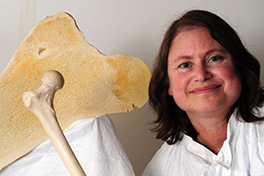A better way to treat metastatic spine tumors?

Targeting the tumor:
- A radioisotope is mixed into bone cement.
- The cement is injected directly into the vertebrae where tumors are located.
- The radiation reaches only the tumor site, resulting in a more precise treatment.
Each year, hundreds of thousands of Americans are diagnosed with a cancer that has spread to the spine — a condition that can be painful and debilitating.
Radiology researchers at UC Irvine have developed a new therapy with the potential to more precisely target a patient’s tumors by injecting radioactive isotopes into the affected bone, itself.
It could also improve quality of life by sparing the patient the risks and side effects of conventional radiation therapy.
Today, metastatic spine tumor patients receive injections of bone cement to strengthen the vertebra and relieve pain before beginning conventional radiation therapy to shrink spinal tumors.
“These patients are often bedridden from the pain,” says Joyce Keyak, PhD, a professor of radiological sciences and biomedical engineering at the UCI School of Medicine.
“After a bone cement injection, many can actually walk. But then they get radiation, and that takes its toll.”
Focused radiation
By mixing radioactive isotopes into the bone cement, Keyak and her collaborators theorized, they could irradiate the affected bone from the inside without harming other tissue.
“Conventional radiation passes through bone and hits everything in its path, causing side effects such as nausea, vomiting and diarrhea," Keyak explains. "For spine tumors, because the spinal cord is right there, we also have to limit the radiation dose that can get to the tumor.”
The new treatment, called brachytherapy bone cement, could be injected directly into the vertebra where the tumor is. Its beta-emitting radioisotopes have a range of only 3 to 6 millimeters — less than 1/4 of an inch — which means the radiation doesn’t affect the spinal cord or anything else.
Eliminating side effects
“It won’t hit the gastrointestinal tract, so people won’t get nausea, vomiting and diarrhea,” she says. “The dosage reaching the spinal cord is much lower, and the radiation is focused where it needs to be, which is in the bone.”
Tests of this new treatment show that the current two-step process — stabilizing the spine followed by radiation treatment — could become a single outpatient procedure.
In addition, brachytherapy bone cement could be used earlier than conventional radiation treatment, which means that would still be an option if spine tumors recur, she says.
After more than a decade of research and persistence, Keyak tested the procedure in a pilot study of six sheep last year. The research was funded by a seed grant from the radiology department and donations.
Promising initial studies
“We put the radioactive cement into three sheep and regular cement into three other sheep,” says Keyak. “The goal was to show that there are no adverse effects — mainly that it doesn’t hurt their spinal cord, and they can still walk around.”
In fact, the sheep with the radioactive cement were on their feet and eating within a few hours. “We ran tests and found no radioactivity in the blood, urine or feces,” she says. “That shows the radioactivity stays localized in the cement and the vertebral body.”
The study was made possible thanks to support and cooperation from the UCI Radiation Safety Division and University Laboratory Animal Resources. “They went out of their way to make sure we could do this study and do it safely,” she says.
Keyak and her team are now actively seeking funding or an industry partner for additional animal studies — the next step before applying to conduct a clinical trial in humans.





